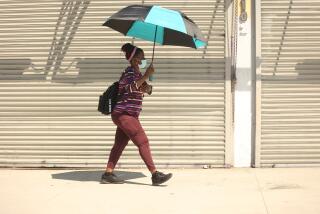Creative Ways to Get Through Dark Summer
- Share via
Let’s begin with neckties. Gov. Gray Davis appears reluctant to invoke his emergency powers and seize electricity plants. Fine. He must have his reasons. Perhaps, though, the governor at least could be moved to issue a proclamation urging Californians not to wear ties this summer. On hot days, in offices with the air conditioning set at 78 degrees, extra material wrapped around the neck will only bring unneeded discomfort.
And so off with the cravats and, to keep things balanced, off with the nylons too. Yes, Davis will take political heat. The necktie and stocking lobbies will march on Sacramento, spinning economic disaster scenarios. Amazing stories will be told of Californians who, but for their neckwear or nylons, might not be alive today.
Still, if California is to squeak through this summer, Davis must remain firm. He might want to lead by example. I’m sensing photo opportunity. Davis and his Cabinet members clustered on the Capitol steps, eagerly yanking off neckwear and hosiery. Big smiles. Many clever headlines and captions playing on themes of “keeping cool” and “cooler heads.”
Today, it should be noted, is not just one more day in the California energy crisis. Today marks the first day of summer. Yes, the season of doom is finally upon us. For months, Californians have been warned that with summer will come rolling blackouts, with all sorts of individual misery and societal meltdown to follow--potentially, anyway. The economy could be gutted. Emergency rooms might fill with the overheated and dehydrated. Six-packs stored in the second fridge could go warm.
And so now is not the time to hold back any coping tips. I’ve collected a few here and there on my rounds. For instance, the earlier reference to thermostats set at 78 comes from Severin Borenstein, director of the University of California Energy Institute in Berkeley. He insists the most effective weapons Californians can wield this summer are to turn off unnecessary lights and set thermostats at 78 degrees. He’s seen statistical projections that indicate these tactics, combined with conservation efforts already in place, “would pretty much make the electricity crisis disappear. That would pretty much end it.”
For those who insist on less direct approaches, however, I pass along a conversation overheard while visiting friends in Fresno. It was amid a hot spell in early May, and blackouts had rolled through the valley the day before. Two young mothers stood in a kitchen and talked about staying cool at night without air conditioning.
“You take a shower and go straight to bed,” advised one.
“I’ve tried that,” said the other, “but it didn’t work.”
“You probably didn’t go straight to bed,” said the first. “You can’t watch TV or straighten up the house. Straight to bed.”
There it is, Californians. Take it.
Another trick from the California heartland: Eat watermelon with salt on it. This is said to help with heat.
I asked the advocate of this old country gambit how it works.
His answer was honest:
“Beats me.”
Under the heading of electricity-free alternatives, one is tempted to revisit the perhaps apocryphal legend of a baby boom said to have followed a massive blackout in New York City in the 1960s. That temptation will be avoided. Instead, here are some G-rated concepts to consider while bracing for electricity outages: Books. Mountains. Ice. Quiet. Coast. Sandals. Lemonade. Barbecue. Clothesline. Shade.
Timing is everything. This is not a 24-hour, seven-day-a-week shortage. The crunch essentially comes in the afternoons and early evening hours of weekdays. Laundry can be left, guilt-free, for the weekend. Location is everything too. More than 40% of the utilities’ customers will be exempt from blackouts, typically because they share circuitry with firehouses, police stations and the like. Californians who would be vulnerable in blackouts might want to identify those relatives or friends who are exempt. This is not a summer for neighbors not to know neighbors.
Indeed, as a Times report Wednesday on worst-case scenarios noted, blackouts could create severe health problems, especially for elderly people living in the interior valleys and desert communities. For most Californians, however, they represent inconvenience, not catastrophe. A common challenge posed by the outages of winter and spring seemed to be figuring out how, with the manuals gone missing, to reset clocks on VCRs. Happily, there is a Web site: https://www.vsda.org. There visitors can find clock-setting instructions for a variety of models. A typical entry:
1. Press the “Menu button.” The Menu screen will appear.
2. Scroll to the “Set clock” option using the “SELECT/SET” Wheel on your remote. Push it to select the “Set Clock” option.
3. Use the “SELECT/SET” Wheel to set the time and date.
4. Press the “MENU” button twice to start the clock and return to normal viewing. The clock is now set.
Now, that doesn’t seem so difficult.
Finally, about the warm beer. . . . As a college kid I worked summers in a feedlot outside Kerman. One hot day, after the cattle had been fed and the bosses had gone home, a few mill-hands gathered in the control room and showed me a trick. They set a warm six-pack on the cement floor, took aim with a fire extinguisher and blasted away. The plume of freezing gas turned the beer cold in a matter of seconds. One way or another, we can survive this thing.







